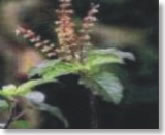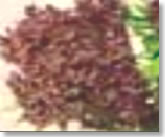
TULASI
Botanical Name: Ocimum sanctum (LAMIACEAE)
English Name: Holy-Basil, Indian Basil, Sacred Basil
Hindi Name: Tulsi

Introduction: Tulsi stands as a model for Hindu culture since ancient times. We come across its description in the vedic literature. It is used in the rituals and offered especially to lord Vishnu during puja. It will be interesting to note the vedic literature quoted it as the fore-bidden herb. The recent studies provind its anti-implantation activity and anti-spermatogenic activity substantiate the ancient view. However, in low therapeutic doses it is useful in respiratory disorders. Charaka enumerated this pant among the herbs effective in dyspnoea (asthma). Susruta used this plant in the treatment of poisoning. Tulasi is also known for its mosquito repellent property.
Distribution: It is a much branched aromatic herb sometimes woody and hairy. It is found almost throughout India and at present being cultivated extensively.
Chemical Constituents: Eugenol, bornyl acetate, camphene, camphor, eugenol methyl ether, humelene, limonene etc.
Parts Used: Whole plant, leaves, root & seeds.
Properties: Acrit-bitter, hot, anti-microbial, febrifuge, anti-malarial, anti-tussive etc.
Indications: Cough, dyspnoea, fevers, infections, malaria, poisoning, leprosy etc.
Dose: Fresh juice 10-20ml; root decoction 50-100ml; seed powder 3-6g.
Therapeutic Uses:
- Cough: Fresh juice of Tulasi is given with honey.
- After delivery: Juice of Tulasi leaves+old jaggery + rice gruel.
Scientific Studies:
Abortificient & antifertility activity: AE (100mg/kg) showed anti-implantation and abortificient activities (Vohora et al., 1969). Benzene and PE extracts ( 100mg/kg) showed 80% & 60% antifertility effect in rats ( Batta & Santakumari, 1971).
Anti-spasmodic activity: 50% ethanolic extract of leaves showed anti-spasmodic activity on guinea pig ileum (Dhar et al., 1968).
Anti-stress activity: Adaptogenic activity in rats & mice has been repoted (Bhargar & Singh, 1981).
Anti-microbial activity: Several workers reported antibacterial, antiviral and antifungal activities (Joshi & Magar, 1952; Grover & Rao, 1977; Tripahti & Tripathi, 1982, Dey & Choudhuri, 1984).
Cultivation Technology: The plant grows on any type of soil but sandy loam with good organic matter is considered ideal. 0.8kg/acre are required. Seed beds of 3x1x0.15 m size are prepared and about 2 kg seeds are sown 2 months in advance of the mansoon. They germinate in 10 days and seedlings are ready after 60 days for transplantation ( 30cm between the row and 20cm with in the row).
Harvesting: Leaves are harvested on the onset of flowering i.e., about 120 days. Second harvest after another 90 days and third harvest 60 days later. It gives about 16,000- 18, 000 kg of herbage (200-250 lt essential oil) per hectare at Rs. 20-30/-per kg.







